L7&8 Neuro/Nervous System
1/126
There's no tags or description
Looks like no tags are added yet.
Name | Mastery | Learn | Test | Matching | Spaced |
|---|
No study sessions yet.
127 Terms
Body Systems
A group of organs which work together to perform common functions
Neuron
a specialised small body cells with long extensions for transmitting impulses which can generate and conduct action potentials
Nerves
A collection of neurons
Neuroglia
Connective tissue that binds together neurons and protects them
Receptor
a body structure that monitors changes in a controlled condition and sends input to a control centre
Control Centre
in the body for example in the brain this evaluates the input it receives from receptors and generates output commands when they are needed
Effector
a body structure that receives output from the control centre and produces a response or effect that changes the controlled condition
Synapse
a region where communication occurs between two neurons or between a neuron and a cell
Functions of the Nervous System
Rapid way of maintaining Homeostasis, creating rapid signals and change within the body in response to internal and external signals to co-ordinate responses of cells and tissues
Two main divisions of the Nervous System
Central (CNS) and Peripheral (PNS)
Central Nervous System
consisting of the brain and the spinal cord this system processes sensory information to better understand it and help us respond appropriately
Brain
Receives and processes sensory information, initiates responses, stores memories, generates thoughts and emotions
Spinal Cord
conducts signals to and from the brain, controls reflect activity
Peripheral Nervous System
this system has neurons that feeds information (sensory) and pushes instructions out (motor)
What makes up the PNS
consists of everything outside the CNS, nervous tissue etc.,
Two main divisions of the PNS
Motor and Sensory Neurons
Efferent
conducted or conducting outwards or away from something
Afferent
conducted or conducting inwards or towards something
Sensory/Afferent Neurons
detects stimuli, carries impulses from receptors in the body to the CNS for processing
Motor/Efferent Neurons
carries impulses from CNS to effectors elsewhere in the body for action and change in response to stimulus that has already been processed in the brain
Two divisions of Motor Neurons
Somatic and Autonomic Nervous System
Somatic Nervous System
Controls voluntary movement
Autonomic Nervous System
Controls involuntary responses, coordinating activities of alertness and rest in the form of sympathetic or parasympathetic divisions
Two divisions of Autonomic Nervous System
Sympathetic and Parasympathetic divisions
Sympathetic response
Fight or flight
Parasympathetic response
Rest and digest
Relay neurons
carry messages from one part of the CNS to another, involved in reflex reactions
What occurs within the nerve cell body
synthesis and transport
Dendrites
forming a large surface area shooting out of the cell body information arrives through these into the cell body to collect information from other neurons
Type of information dendrites collect
sensory from receptors or information from another synapse with another neuron
Axon
a single nerve conducting in only one direction carrying a nerve impulse away from the CNS and towards the region of the body in which an effect is made
Axon Hillock
the area where the Axon is leaving the cell body
Axon terminals
branches at the end of the Axon which may synapse signals to other neurons or receptors
Trigger zone
the initial area between the axon hillock and the initial segment where the nerve impulses begin
Myelin Sheath
a multi-layered lipid and protein insulating coverage that wraps around long and wide axons in intervals
Functions of Myelin Sheath
speeds up and makes conduction more efficient by electrically insulating the axon
Myelin created by in PNS
Schwann cells
Myelin created by in CNS
Oligodendrocytes
Current
the flow or movement of charge (energy) between two points
Example of current in NS
from the cell body the trigger of nerve conduction from the axon hillock along the axon to the axon terminals
Voltage
the potential for movement
Voltage relationships
the bigger the difference between the two points the bigger potential for movement
Example of voltage in NS
the difference in charge between the inside and the outside of the axon
Resistance
either to movement or to the current moving along an axon which can disrupt a signal therefore affecting the voltage
Ions moved across membranes
Sodium and potassium from the axon hillock along the axon
Resting potential
the potential difference across a neurons membranes when no nerve impulses are being actively transmitted
Threshold potential
the minimum level of membrane depolarization a neuron must reach to fire an action potential
Action Potential
a sequence of rapidly occurring events that initiates a rapid rise and fall in voltage across a cell membrane
Depolarisation
the process where a cell's internal electrical charge becomes less negative, shifting closer to zero
Repolarisation
the process by which a cell returns to its negative resting membrane/potential
Resting potential Voltage
-70mv
Threshold potential
-55mv
Action potential Voltage
up to 40mv
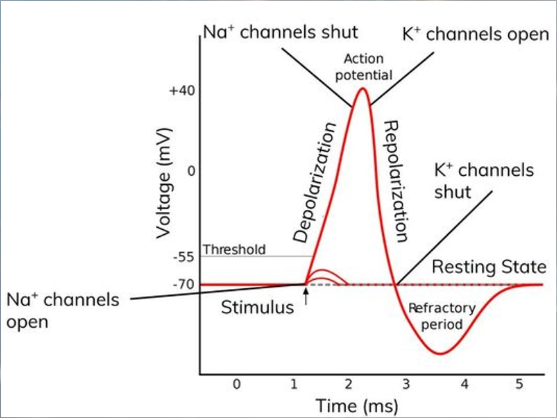
Process explained (basic)
Prior to the signal the cell will be at resting/voltage potential (-70mv), incoming signals from dendrites diffuse to the axon hillock, if a threshold potential (-55mv) is reached a an action potential will be generated (up to 40mv) travelling down the axon towards the axon terminal
Refractory period
after repolarisation the membrane drops down towards resting potential but decreases too far passing it, during which the neuron cannot be restimulated until the membrane is reset back to resting potential
Ion channels
spanning the phospholipid bilayer of the plasma membrane, these protein cross-membrane pores can open to allow ions to pass through to the cell membrane therefore creating an intercellular ion balance
Passive Channels
located in some areas of the body these channels are always open
Mechanical Channels
gated channels that open in response to mechanical stimulus (touch, pressure, vibration or tissue stretching)
Ligand-gated ion channels
gated channels that open in response to binding specific molecules such as neurotransmitters allowing for cell to cell communication and a wave of current to pass from one neuron to the next
Examples of ligand-gated ion channels
from axon terminals to dendrite of next neuron/cell where the effect or change from stimulus must occur
Voltage-gated ion channels
gated channels that open in response to voltage stimulus/change in membrane potential allowing a wave of depolarisation to move along the membrane
Example of voltage-gated ion channel
the signal conducted from the axon hillock along the axon to the axon terminals through these
Nodes of Ranvier
signals jump between this unmyelinated areas of the axon as areas of it with the myelin sheath cannot be depolarised
Saltatory Conduction
action potential jumps which occurs across myelinated axons only
Impact of size of axons
larger neurons with bigger and wider axons have less resistance therefore more rapid conduction
Non-myelinated axons
slow as each neighbouring Na+ channel must be open
Na+
Sodium
Process explained (advanced)
Prior to the signal the cell will be at resting/voltage potential (-70mv), incoming signals from dendrites diffuse to the axon hillock, if a threshold potential (-55mv) is reached an action potential will be generated (up to 40mv) and voltage gated sodium channels will open resulting in movement of Na+ channels across the axon membrane causing a state of depolarisation, at this point potassium channels open and further movement of ions occurs causing repolarisation of the membrane dropping back down towards its resting potential instead decreasing past it to the refractory period continuing down the axon until the signal reaches the axon terminal
K+
Potassium
A Fibres
myelinated with large diameter allowing signals to pass at 300mph
B Fibres
light myelination with medium diameter allowing signals to pass at 30mph
C fibres
no myelination with smaller diameter allowing signals to pass at 2mph
Ca
Calcium
Vesicles
organelles in a neuron's axon terminal that store and transport neurotransmitters
Neurotransmitters
chemical messengers that transmit signals from one neuron to another across a synapse, or from a neuron to a muscle or gland cell
Examples of neurotransmitters
adenosine, acetylcholine, dopamine, noradrenaline, serotonin
How does an action potential travel across a synapse?
An action potential arrives at the pre-synaptic terminal and depolarises the membrane, voltage gated Ca channels open and enter the axon, Ca stimulates vesicles containing neurotransmitters to be released into synaptic cleft, neurotransmitter diffuses across the synaptic cleft using simple/passive diffusion, Neurotransmitter binds to receptor on post synaptic terminal, action potential can continue
Coding
the frequency of action potentials that are generated by a stimulus dependant on the size of the stimulus
Coding Example
the larger the stimulus the greater the frequency of action potentials sent to the CNS and sustained depolarisation at the axon hillock therefore an increased intensity of perception of stimulus for example difference between warm and hot
Multiple Sclerosis MS
this is an autoimmune disease whereby immune cells are activated against antigens of the CNS, demyelinating axons meaning reduced action potential transmission and eventual loss of the neuron
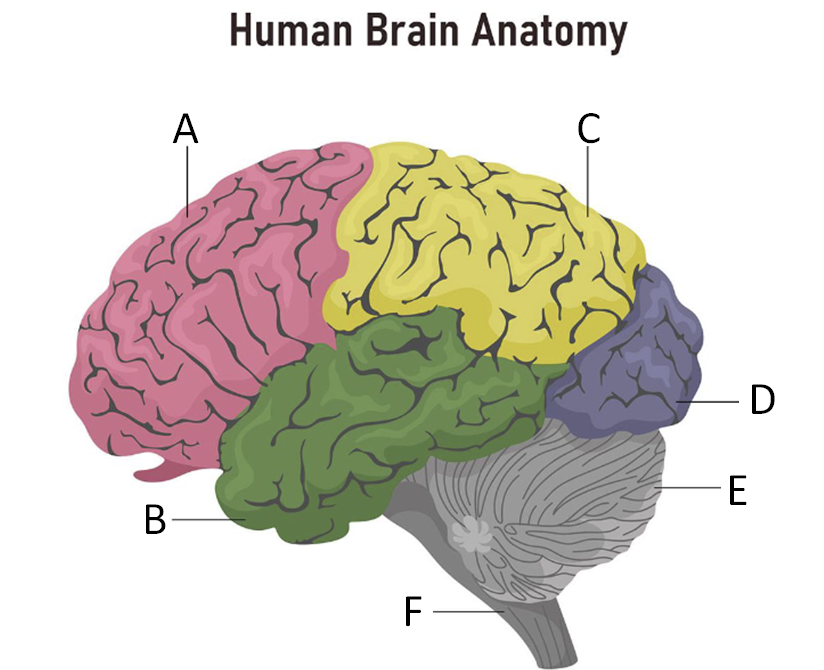
A
Frontal lobe - memory
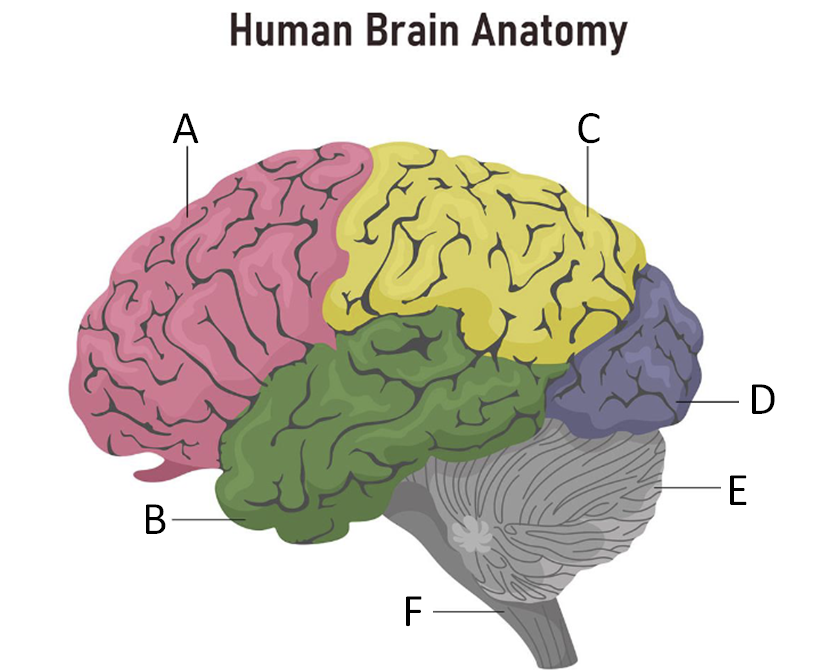
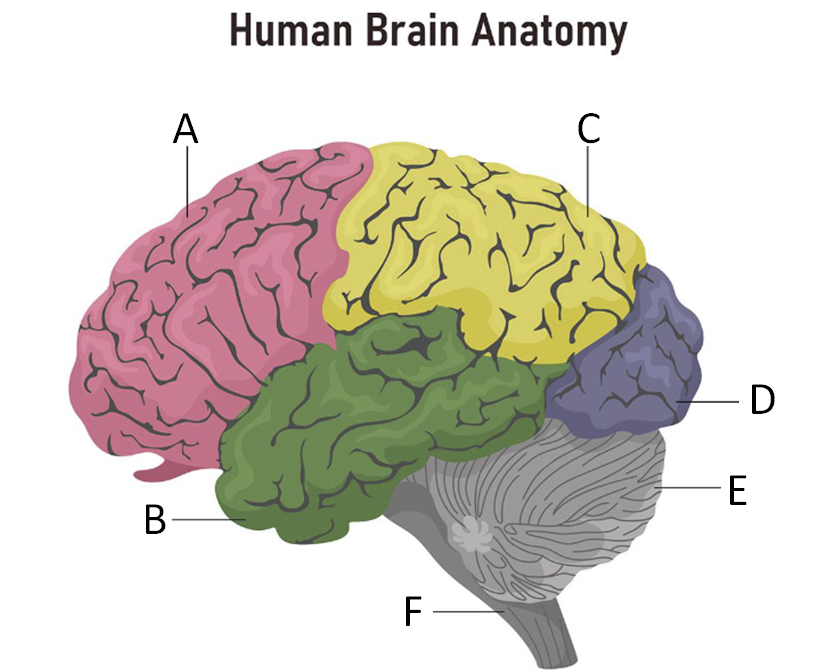
B
Temporal lobe - hearing
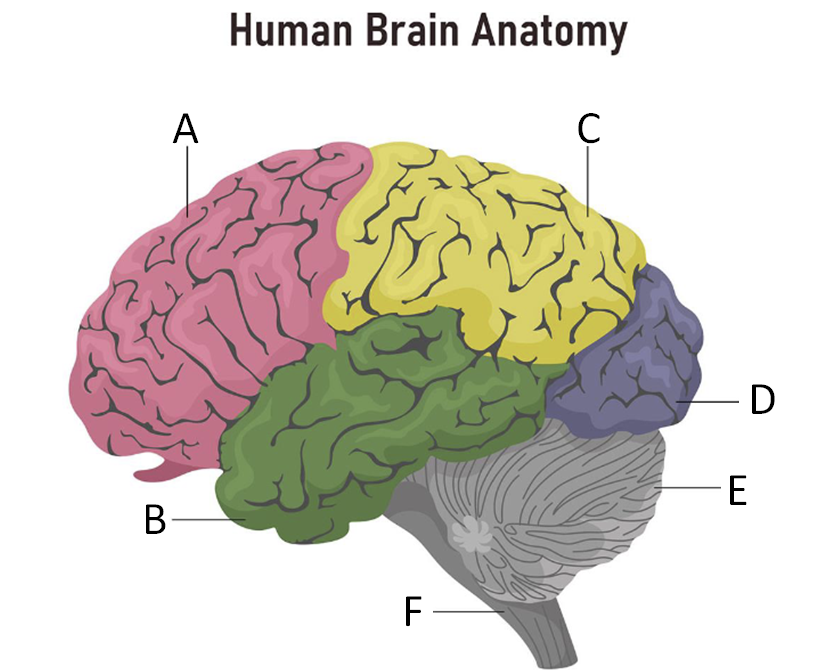
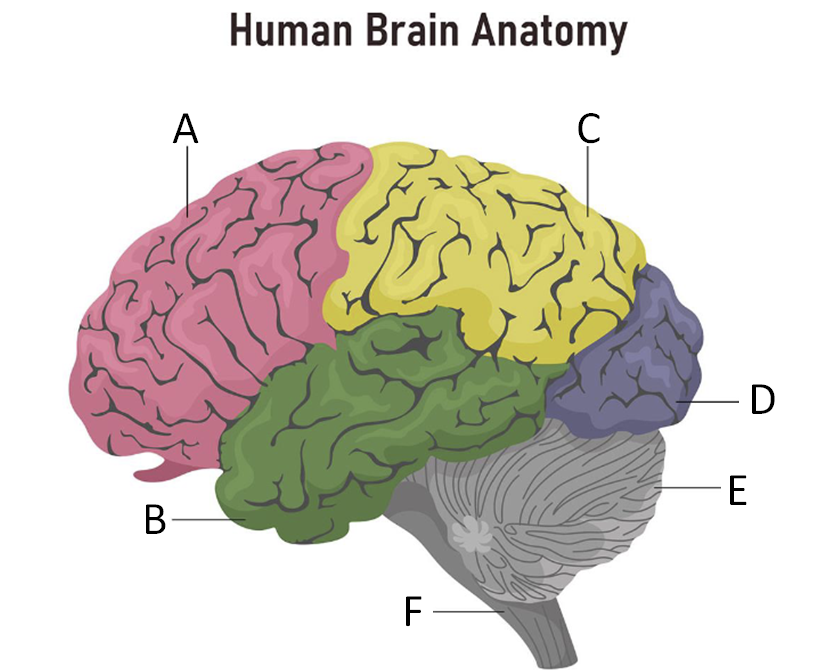
C
Parietal lobe - sensory (pain, heat, pressure)
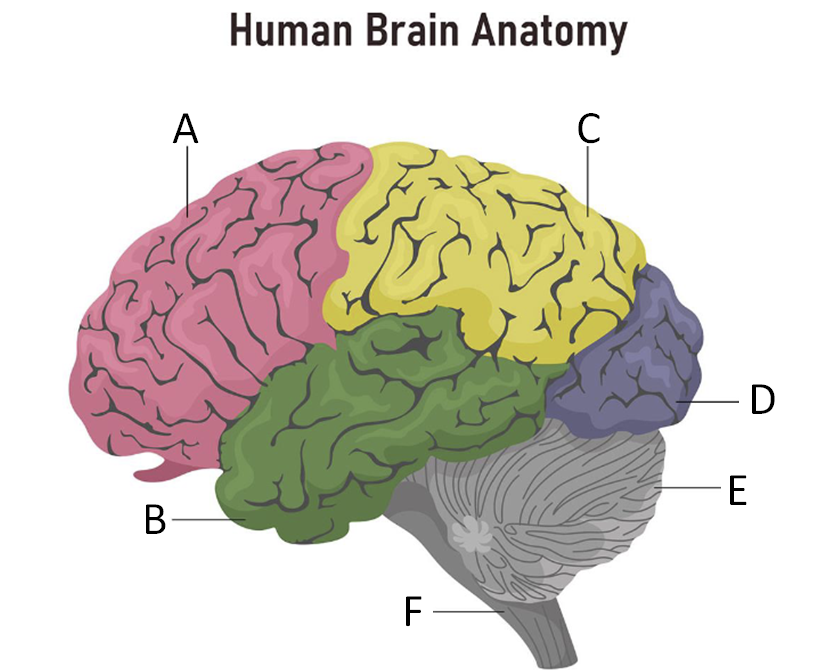
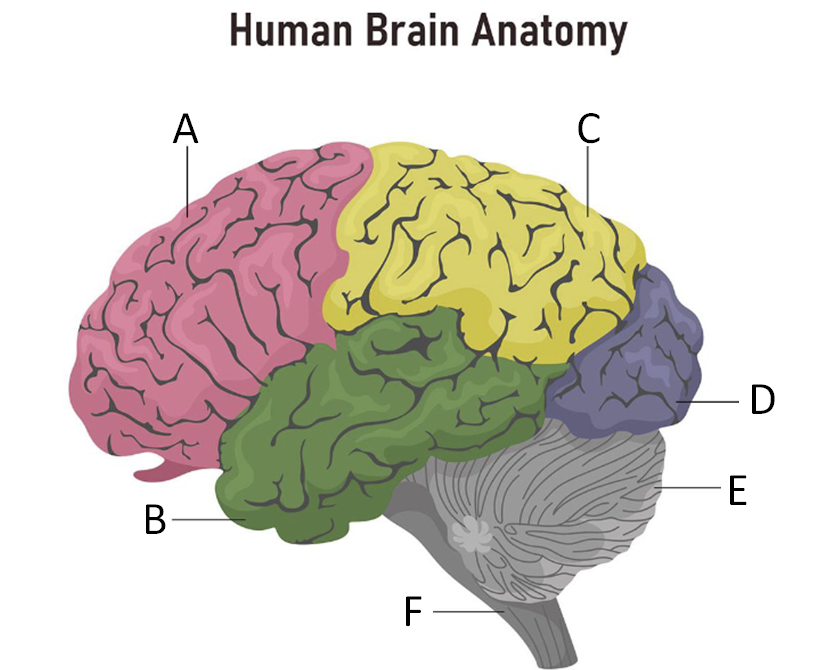
D
Occipital lobe - sight and visual processing
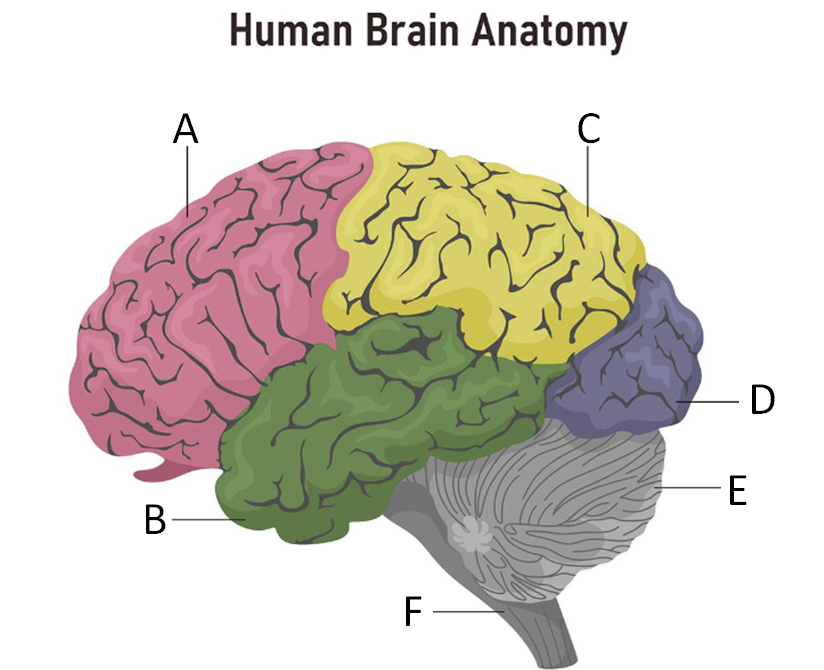
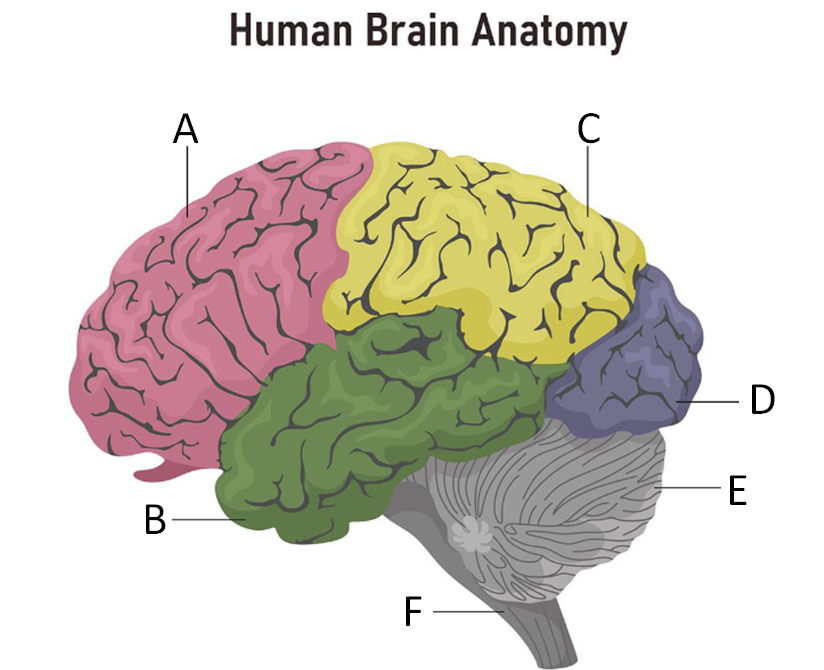
E
Cerebellum - balance and posture
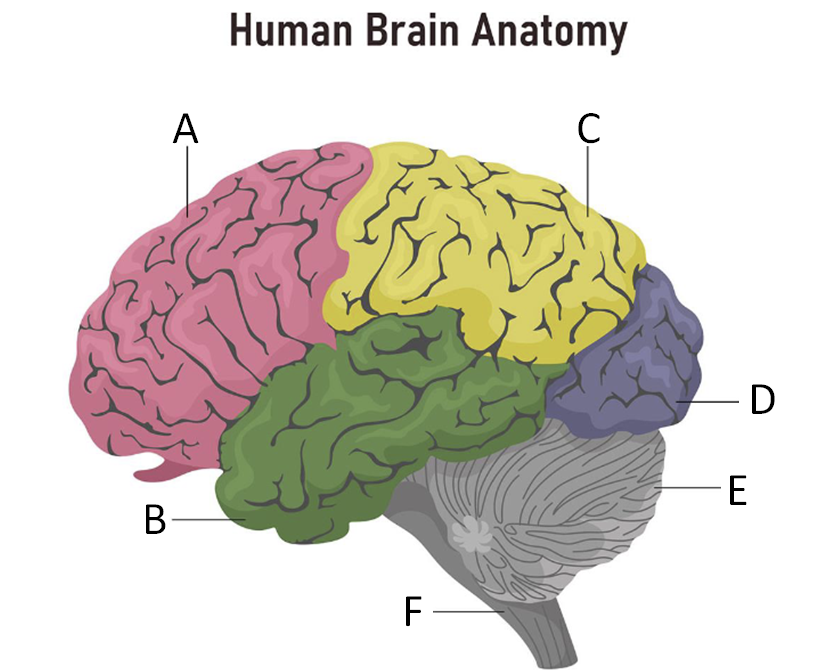
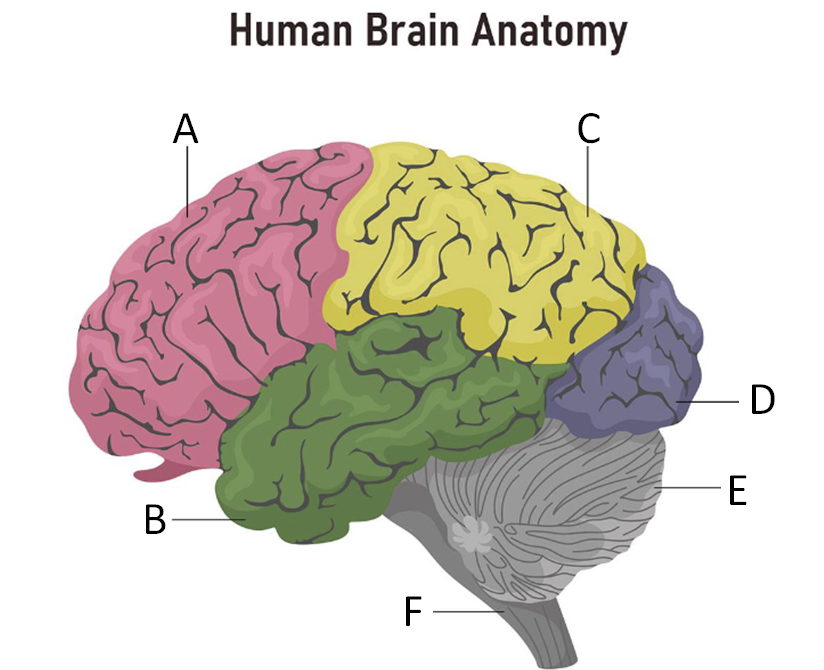
F
Spinal cord
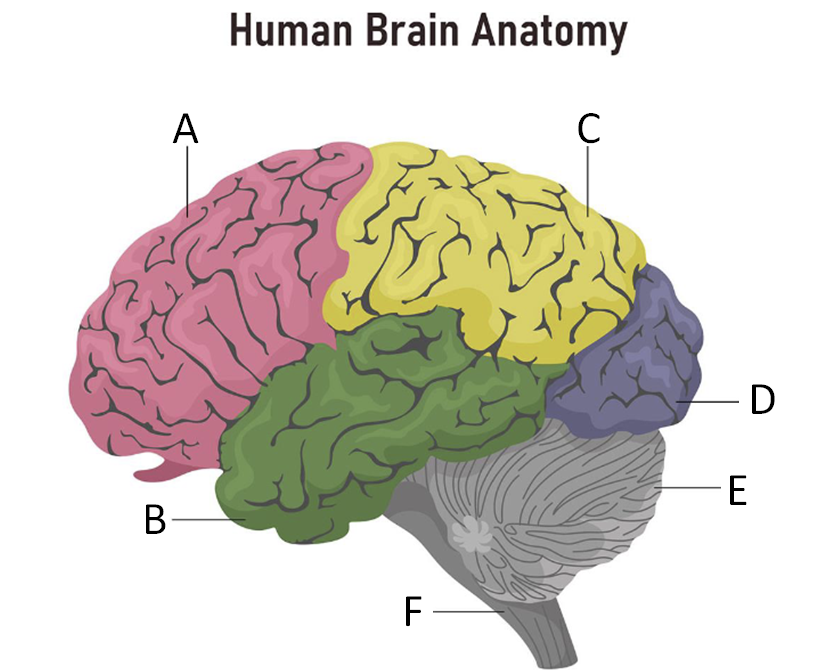
Meninges (layers of brain)
Dura mater, Arachnoid mater, Subarachnoid space, Pia mater
Dura mater
outer layer lining skull
Arachnoid mater
contains blood vessels
Subarachnoid space
filled with cerebral spinal fluid
Pia mater
covers brain
Cerebral spinal fliud
provides nourishment, waste removal, protection and is the optimum environment for nerve signalling
Blood-brain barrier
tight junctions that seal together endothelial cells of capillaries and basement membrane that surrounds capillaries
Functions of blood-brain barrier
Glucose able to travel across via active transport, trauma, inflammation and toxins such as alcohol and opioids can break down (not all drugs can)
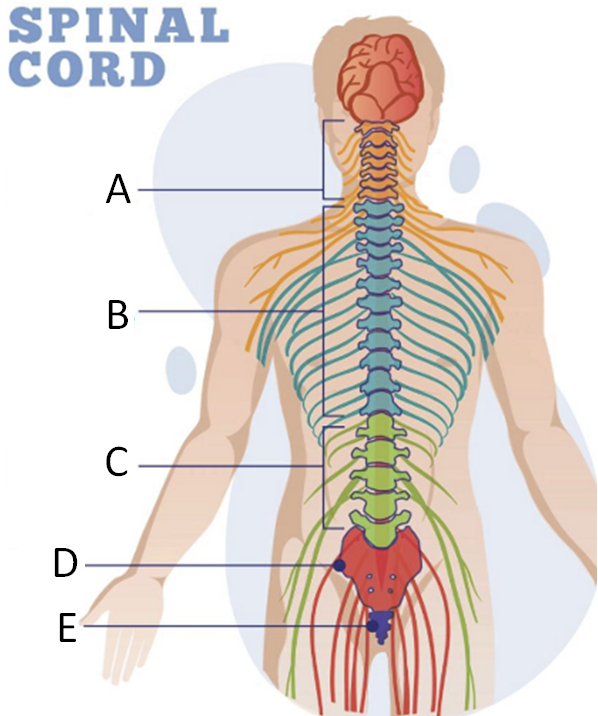
A
Cervical spine vertebrae
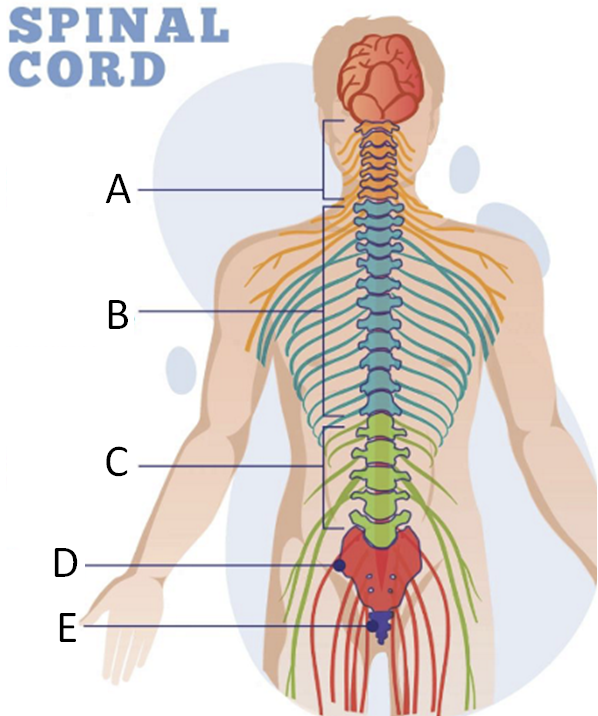
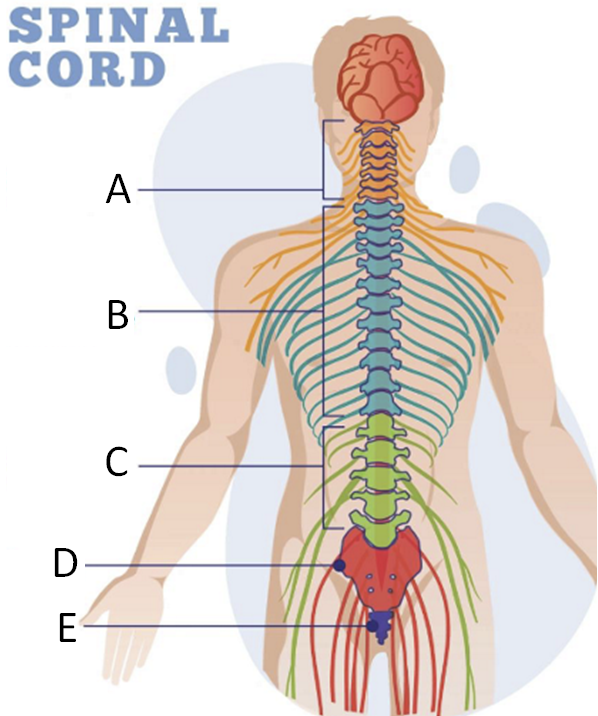
B
Thoracic spine vertabrae
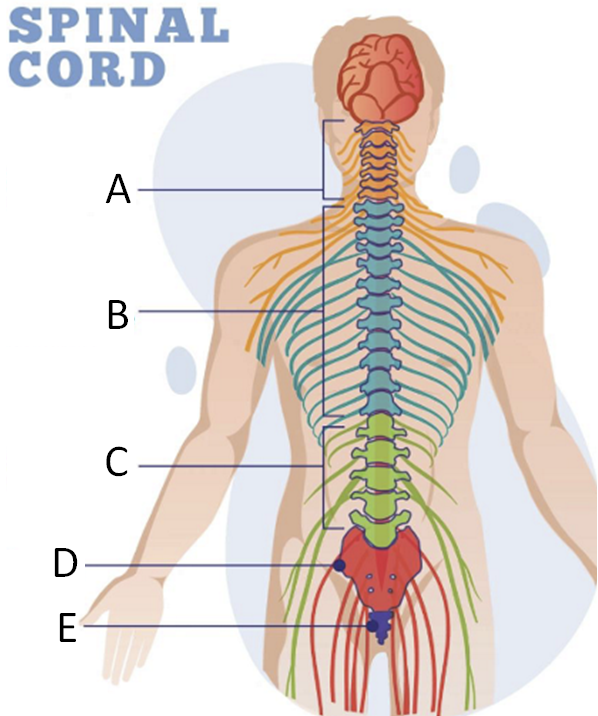
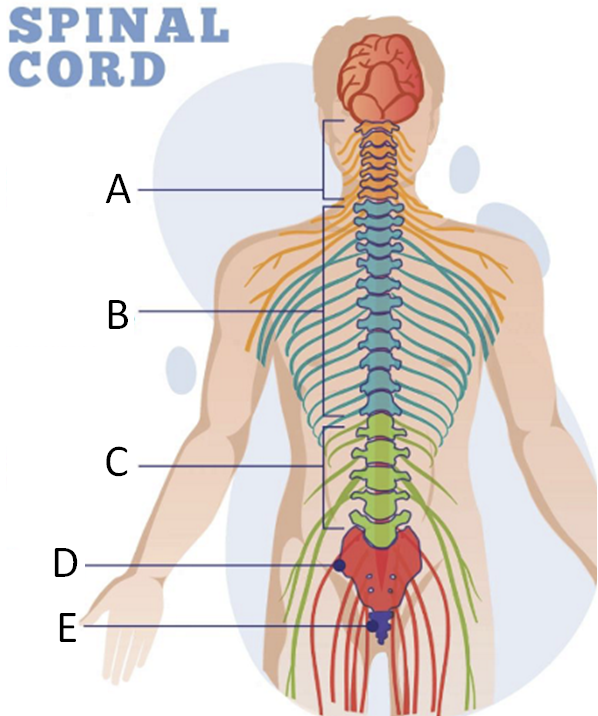
C
Lumber spine vertebrae
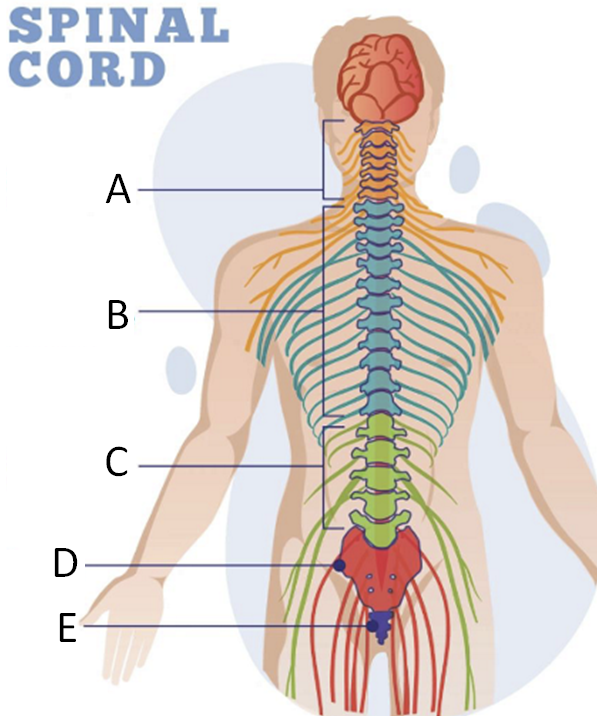
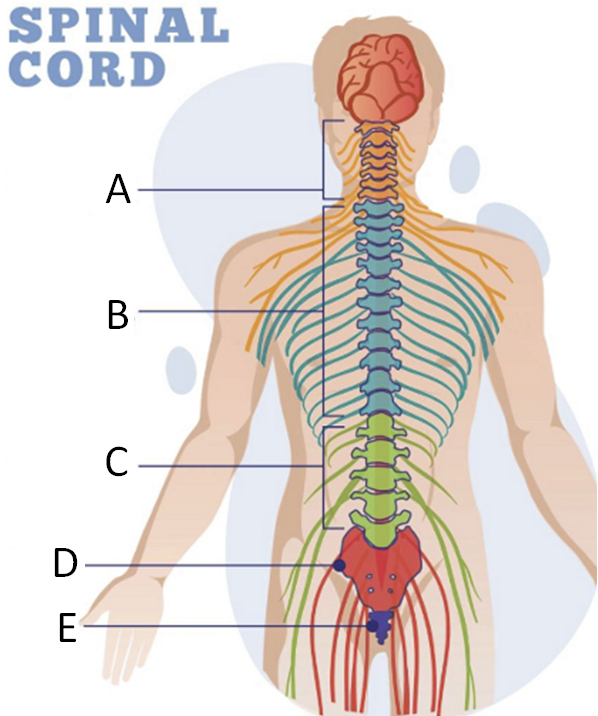
D
Sacrum
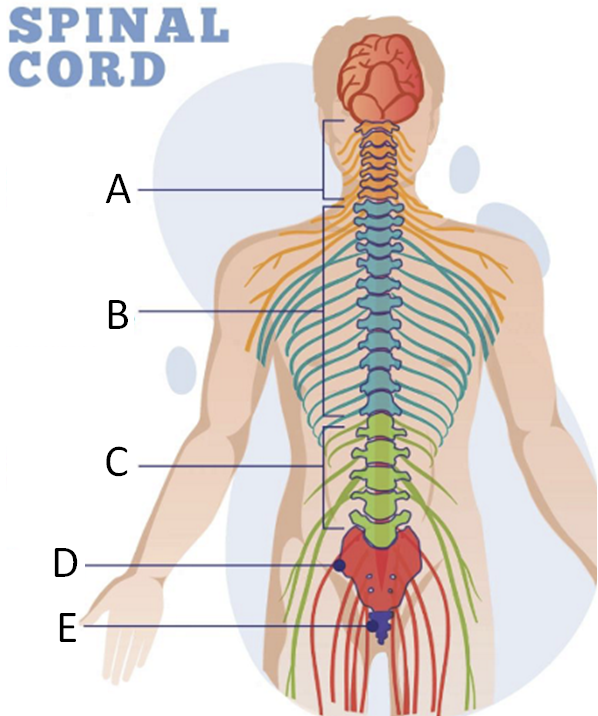
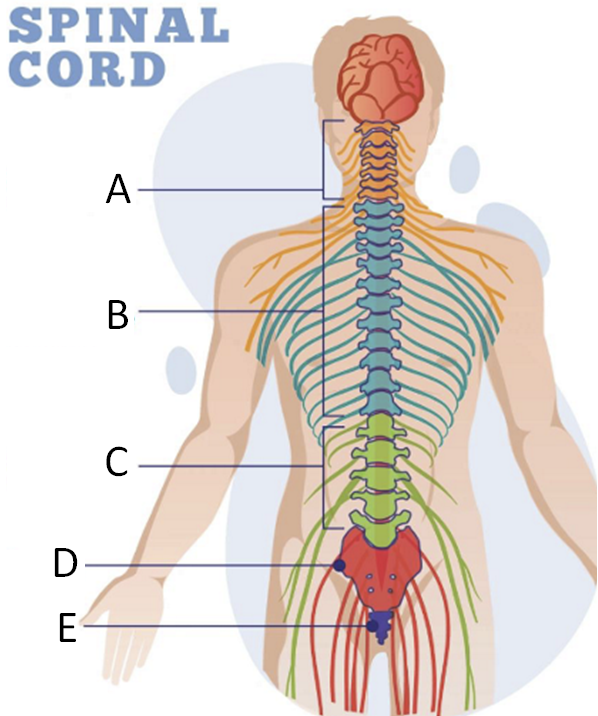
E
Coccyx
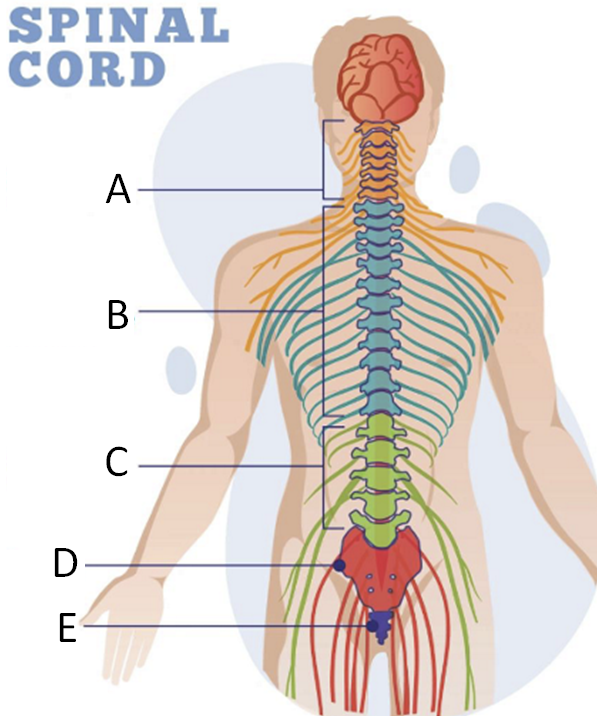
Vertebrae of spine
born with 33 vertebrae, by adulthood have 24 due to sacrum and coccyx fusing as well as others